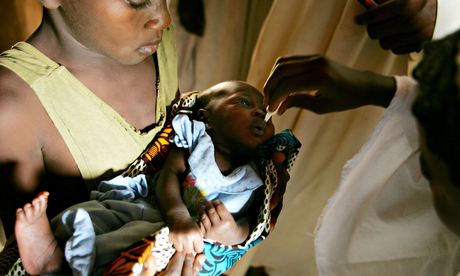
The pharmaceutical market requirements todevelop the next generation of vaccines with heat stability targets to stay away from cold chain requirements. Photograph: Chris Hondros/Getty Photographs
Immunisation is widely accepted to be 1 of the excellent public overall health successes of recent decades, contributing to a substantial fall in kid mortality close to the world. Yet, each 12 months, 22 million kids fail to get completely vaccinated, leaving them vulnerable to deadly diseases.
The consequences of this vaccination failure are costly, the two in terms of youthful lives misplaced unnecessarily and in terms of pricey emergency public overall health interventions needed to respond to outbreaks of communicable ailment – interventions that cost millions of euros.
One particular substantial element behind this failure is the vaccines themselves and their lack of suitability for the settings with the weakest wellness techniques. For the past thirty many years, the variety 1 rule has been that all vaccines need to have to be kept amongst two and 8C correct up to the stage of delivery, a method identified as the ‘cold chain’. In nations with unreliable electrical energy supplies, poor transport hyperlinks, remote communities and large temperatures, the logistical problems are apparent and too usually go unmet.
Of program more interest, and money, require to be paid in the direction of strengthening logistics and cold chain methods in these poorer countries, but we also need a lot more action from the vaccine companies to decide the true thermostability of vaccines, and a regulatory framework that acknowledges and expedites this actuality. This would enable wider use of a more versatile cold chain, frequently described as a ‘controlled temperature chain’, or CTC, in which some vaccines are able to be securely kept unrefrigerated for specified periods of time. The fiscal rewards can be large – in one study in Chad, keeping vaccines in a CTC, rather than in a conventional cold chain, halved the cost of reaching each and every patient.
There is an rising physique of scientific proof that numerous current vaccines are in fact a great deal a lot more heat-stable than their labelling suggests and can stay powerful in spite of getting exposed to warmer temperatures. Scientific scientific studies conducted by MSF in 2013, for instance, demonstrated that the Serum Institute of India’s tetanus toxoid vaccine remains efficacious in spite of getting exposed to temperatures of up to 40C for 30 days. Other well being organisations, such as the Programme for Suitable Technological innovation in Health (Path) and WHO, are starting to compile this information.
Nevertheless even the place there is firm proof that vaccines are significantly heat-stable, makers are dragging their feet more than relabelling and relicensing their vaccines. The regulatory procedure essential to do so is unclear and possibly time consuming. At present, there is just no incentive for firms such as Pfizer or GlaxoSmithKline to bother with the expense and hassle of relicensing a vaccine for CTC use. Alas WHO, which is not itself a regulatory body, cannot approve or recommend new storage conditions beyond individuals set out by the medicine regulatory agency in the nation of manufacture.
In the meantime, some organisations are tackling the problem head-on themselves. WHO in the western Pacific region noticed the require to improve coverage charges of the hepatitis B virus (HBV) vaccine at birth and advised that midwives and birth attendants working in communities not equipped with electrical energy be allowed to keep the HBV vaccine for up to thirty days at ambient temperatures under 40C. This has been credited with helping to improve HBV birth dose coverage in the region, despite the fact that a much more formal relicensing of the vaccine is still needed.
In the long term, the next generation of vaccines must be produced with ambitious heat stability targets so that burdensome cold chain needs can be avoided from the outset. A good example is MenAfriVac for meningitis. A vaccine produced specifically for the sub-Saharan Africa meningitis belt, at the moment the only vaccine recommended by WHO for use in a CTC. MenAfriVac can be employed for up to 4 days outdoors the cold chain in ambient temperatures of up to 40C.
As a public wellness local community, we know what demands to be done. Pharmaceutical organizations require to label vaccines to reflect their accurate heat stability and to invest in ensuring that new vaccines are as heat-steady as feasible. WHO, with the support of national governments and their regulatory companies, must clarify the pathway to employing vaccines outdoors the strict cold chain. We need to have to offer overall health workers with the equipment they want to efficiently run vaccination programmes in resource-poor settings. If we do this, we will conserve income and assets, whilst making sure far more young children survive. Surely its an work worth making.
Read a lot more stories like this:
• Melinda Gates on the nine players modifying the vaccine game
• DIY biotech: how to build by yourself a low-value malaria detector
• Modern information assortment is key to attaining immunisation objectives
Kate Elder is the vaccines policy adviser for Médecins Sans Frontières’ Accessibility Campaign.
Join the neighborhood of global advancement experts and experts. Turn into a GDPN member to get far more stories like this direct to your inbox
Vaccine improvement: thinking out of the cold box
Hiç yorum yok:
Yorum Gönder